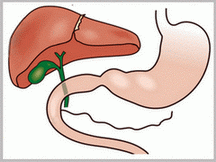
Gallbladder symptoms
Table of Contents
About me
Categories
Text
What is Biliary colic?
Biliary colic is the most common symptom of patients with gallstones. Repeated low-grade inflammation can lead to chronic cholecystitis (a histological diagnosis), characterized by a thickened, shrunken and fibrosed gallbladder.
How common is biliary colic?
Biliary colic is common. The incidence is 2000 per 100 000 per year in patients with gallstones. The incidence decreases with time, to approximately half after 5 years as 30% of patients only ever experience one episode. The exact prevalence of biliary colic is difficult to determine as both gallstones and upper abdominal pain are common and often go undiagnosed.
Pathology
The symptoms of biliary colic arise from distension and spasm of the gallbladder from an impacted gallstone in the gallbladder neck obstructing the cystic duct and normal flow of bile. Once the impacted stone falls back from the gallbladder neck, the gallbladder empties and the pain ceases.
Scope of disease
Continued impaction of the stone results in chemical inflammation and can lead to acute cholecystitis. Recurrent episodes of biliary colic result in low-grade inflammation leading to chronic cholecystitis. Gallstone impaction in Hartmann's pouch when the gallbladder is empty may result in mucus secretion from the gallbladder leading to a mucocele.
Clinical features
Biliary colic is a misnomer, as the pain is typically constant. It is usually a severe pain experienced in the right upper quadrant or epigastrium. The onset of pain is rapid and the duration is usually more than 15 minutes, resolving within 24 hours. Biliary colic may be precipitated by fatty food and radiate to the scapula.
Examination reveals right upper quadrant tenderness in an afebrile patient. Fever, jaundice, Murphy's sign, systemic upset or signs of peritoneal irritation indicate the development of other complications. A palpable gallbladder suggests a mucocele.
Initial investigations
Full blood count, liver profile and amylase
Full blood count, liver profile and serum amylase are normal in biliary colic.
Ultrasound of the abdomen
Ultrasound scanning confirms the presence of gallstones in the gallbladder.
Further investigations
Upper gastrointestinal endoscopy
If ultrasonography is normal, upper gastrointestinal endoscopy should be performed to exclude peptic ulcer disease, gastritis and gastro-oesophageal reflux disease.
Initial management
Analgesia
Biliary colic is usually managed in the community with oral analgesics, but intramuscular diclofenac may prevent progression to acute cholecystitis. If analgesia is inadequate, hospital admission for intravenous opiates is required until the pain settles.
Surgical management
Cholecystectomy
Elective cholecystectomy has become the standard therapy for gallstones causing biliary colic. The advantages over medical therapy are: no restrictions on the number, size or type of gallstone, rapid stone removal, prevention of recurrence and elimination of any risk of gallbladder cancer.
Cholecystectomy may be undertaken with a laparoscopic or open approach Over the last decade, laparoscopic cholecystectomy has become the operation of choice by surgeons and the general public, such that the open approach is now seldom performed as the first choice. This is despite randomized trials showing similar outcomes when a small incision open approach is compared to the laparoscopic approach.
Labels: Gallbladder symptoms
0 Comments:
